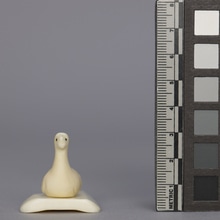
Figure
MOA: University of British Columbia
3040/13
Carving of an eider duck on top of water. The water is a rectangle of tusk. Black inset eyes and incised feathers. The name of the bird "Meetil-lu" is written on the base in black ink.
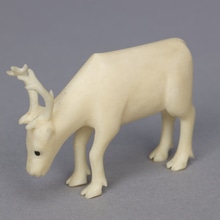
Caribou Figure
MOA: University of British Columbia
3040/12
Carving of a caribou with head bowed as if grazing. Black inset eyes.
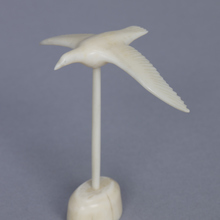
Bird Figure
MOA: University of British Columbia
3040/11 a-b
Bird with wings outstretched in flight (part a). Bird's beak and eyes are incised and feathers are incised on wings and tail. There is a hole in the base of the bird that fits onto a long peg/stick which fits into a hole in an oval base (part b).
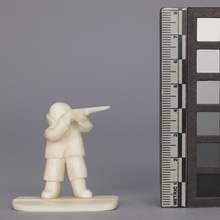
Figure
MOA: University of British Columbia
3040/10
Carving of a man holding a rifle in the act of aiming. Man's hood is back and his hair has been lightly incised and darkened with ink. He has no facial features. Man is attached by two metal pegs to a rectangular tusk base.
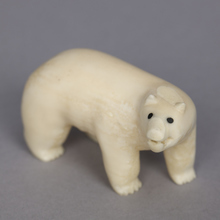
Figure
MOA: University of British Columbia
3040/9
Carving of a bear on four legs with head turned to the right. Black inset eyes. Bear's mouth is open and six teeth, including two canines, are present. Claws are present on all four paws.
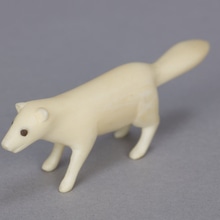
Figure
MOA: University of British Columbia
3040/8
Carving of a fox standing on all four legs with its tail pointed out directly behind. Black inset eyes. Mouth is open but no teeth have been carved. Nostrils are present and have been marked with ink.
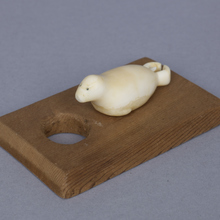
Figure
MOA: University of British Columbia
3040/7 a-b
Wooden rectangle with a hole in it (part a), and a seal carved in walrus tusk (part b). The seal is positioned as if about to slide from the ice (the wood) into its breathing hole. There are two holes in the base of the seal that attach to two tusk pegs in the wooden base.
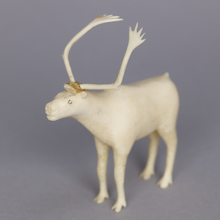
Figure
MOA: University of British Columbia
3040/6
Sculpture of a caribou with antlers and incised facial features. Caribou faces forward. One antler has detached from the adhesive.
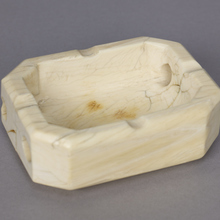
Ashtray
MOA: University of British Columbia
3040/5
Ashtray in the form of a rectangle with cut off corners. It has been created from two pieces of narwhal tusk pegged together. There are four rests for cigarettes, one on each side of the rim. There are also four holes that have been drilled through the piece which are slightly larger than the dia...
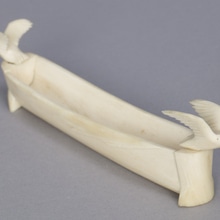
Dish
MOA: University of British Columbia
3040/4
Small elongated, oval dish with two pedestal feet. There is a bird perched at each end of the dish facing outwards with their wings raised as if in flight. The bird species are written on the base in pencil: one is "Nowya" which is seagull (Nauja in Inuktitut), and the other is "Kiing-ma-la".